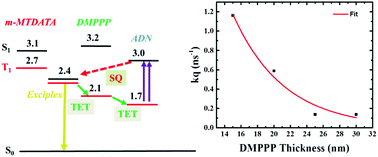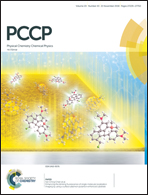Exciton dynamics in heterojunction thin-film devices based on exciplex-sensitized triplet–triplet annihilation†
Abstract
Exciton dynamics in a solid-state exciplex sensitized triplet–triplet annihilation (ESTTA) system are studied using transient photoluminescence (TrPL) measurements. The ESTTA system is a trilayer structure with 4,4′,4′′-tris(N-3-methyphenyl-N-phenyl-amino)triphenylamine (m-MTDATA) acting as the electron donor, 1-(2,5-dimethyl-4-(1-pyrenyl)phenyl)pyrene (DMPPP) as a triplet-diffusion-singlet-blocking (TDSB) layer, and 9,10-bis(2′-naphthyl) anthracene (ADN), acting as the electron acceptor and emitter. The thicknesses of the m-MTDATA and ADN layers are 30 nm, while the thickness of the DMPPP layer is varied to characterize its effect on the singlet quenching of the ADN emission. We find that electron transfer via tunneling through the DMPPP layer is the dominant quenching channel, with a characteristic length of ∼5 nm. Doping the high photoluminescence quantum yield molecule 4,4′-bis[2-(4-(N,N-diphenylamino)phenyl)vinyl]biphenyl (DPAVBi) into the ADN layer enhanced the overall intensity of the ESTTA signal but did not prevent quenching by exciplex formation. The trilayer configuration (m-MTDATA/DMPPP/ADN) can effectively prevent ADN singlets from being quenched by electron transfer and exciplex formation, and a key property of the DMPPP is its tendency to not undergo electron transfer to the ADN.



 Please wait while we load your content...
Please wait while we load your content...